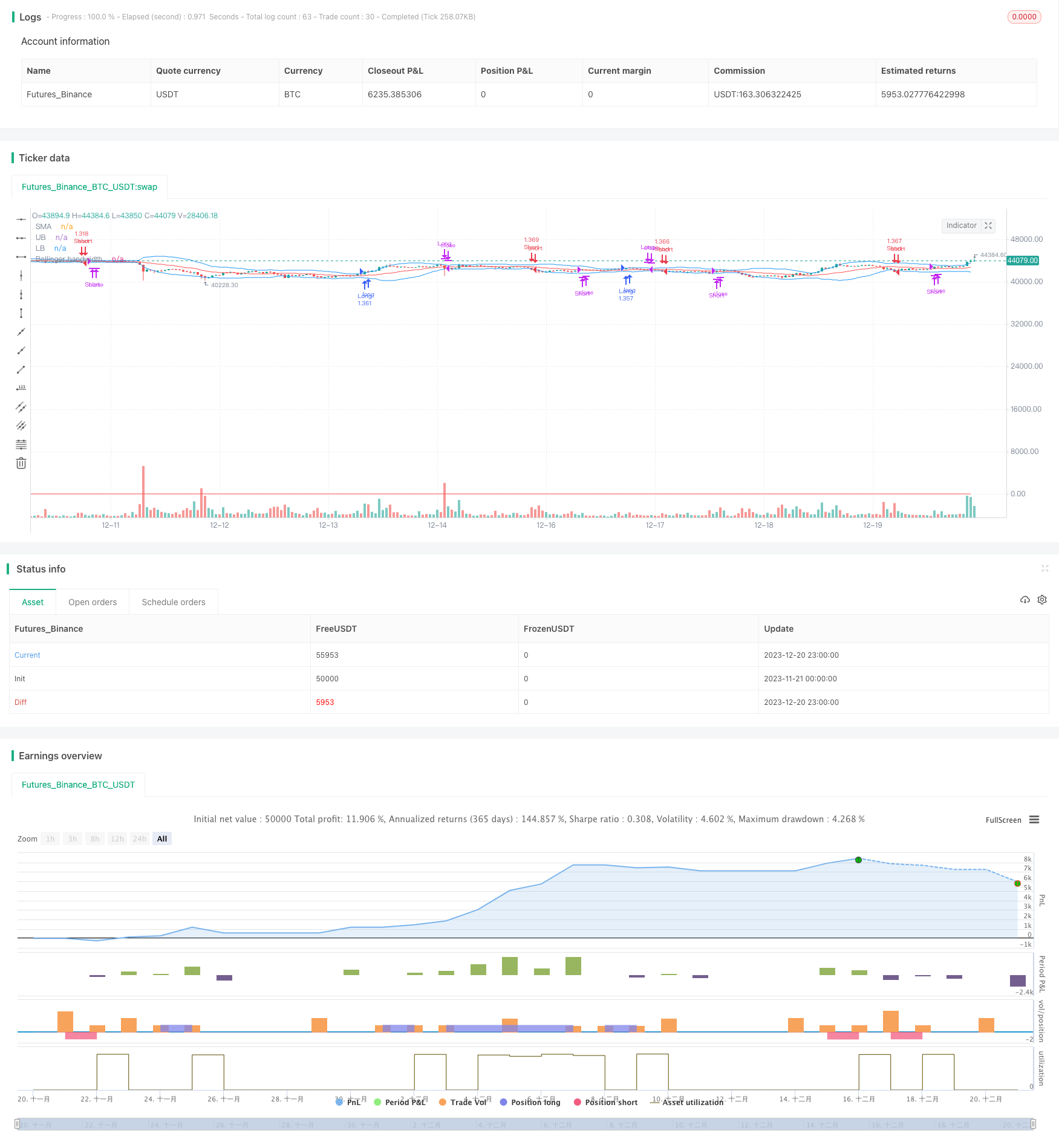Bollinger Momentum Breakout Strategy
Author: ChaoZhang, Date: 2023-12-22 13:09:32Tags:

Overview
This strategy uses Bollinger Bands to determine market trend direction combined with RSI indicator to filter bullish signals, implementing momentum breakout operations to chase rises and kill falls. The basic idea is: when the price breaks through the Bollinger upper band, go long; when the price breaks through the Bollinger lower band, go short.
Strategy Principle
-
When Bollinger Bands indicator determines the price breaks through the upper band, it indicates the market enters a bullish trend. At this time, use RSI indicator for filtration. Generate buy signal when RSI is greater than 60. When BB indicator determines the price breaks through the lower band, it indicates the market enters a bearish trend. At this time, use RSI indicator for filtration. Generate sell signal when RSI is less than 40.
-
Set stop loss after entering the market to avoid further losses.
-
Exit criteria is closing long position when price breaks back below BB middle band, and closing short position when price breaks back above BB middle band.
Advantage Analysis
-
Bollinger Bands indicator can determine major market trend and capture inflection points. Combining with RSI filter can improve signal reliability.
-
Chase rises and kill falls operation can achieve excess returns.
-
Setting stop loss can control risks.
Risk Analysis
-
BB indicator is not effective in judging sideways markets, which can generate false signals.
-
Improper stop loss setting may lead to further losses.
-
High trading frequency is impacted by trading costs and slippage.
-
Breakout signals need timely update, otherwise best entry opportunities may be missed.
Optimization Directions
-
Combine with other indicators to judge reliability of BB breakout signals, such as volume, moving averages etc.
-
Dynamically adjust BB parameters to optimize indicator performance.
-
Optimize stop loss position, such as trailing stop loss, percentage stop loss to reduce unnecessary losses.
Summary
The strategy has a clear logic to determine market trend through BB and filter signals with RSI for momentum trend chasing. It features high operation frequency, fast profit/loss cycles, more suitable for traders pursuing excess returns. However, high trading frequency also increases transaction costs and requires strict capital management and emotional control. Further performance and stability improvement can be achieved through parameter optimization and stop loss optimization.
/*backtest
start: 2023-11-21 00:00:00
end: 2023-12-21 00:00:00
period: 1h
basePeriod: 15m
exchanges: [{"eid":"Futures_Binance","currency":"BTC_USDT"}]
*/
//@version=4
strategy(title="Bollinger Band Breakout", shorttitle = "BB-Stoxguru",default_qty_type = strategy.percent_of_equity,default_qty_value = 100, overlay=true)
source = close
start = timestamp (2007, 1,1,0,0)
end = timestamp (2021,11,05,0,0)
stop_level = (high[1]-low[1])
profit_level = (high[1]-low[1])
length = input(20, minval=1, title = "Period") //Length of the Bollinger Band
mult = input(2, minval=0.001, maxval=50, title = "Standard Deviation")
basis = sma(source, length)
dev = mult * stdev(source, length)
upper = basis + dev
lower = basis - dev
band=upper-lower
stop_loss=low-atr(14)
if time >= start
// and time < end
strategy.entry("Long", strategy.long, when = crossover(source, upper) and rsi(close,14)>=60 and rsi(close,14)<=70)
// strategy.entry("Long", strategy.long, when = crossover(source, upper) and rsi(close,14)>60 and band<200)
// strategy.exit("SL", "Long", stop=stop_loss)
strategy.close(id="Long", when=crossunder(close, basis))
strategy.entry("Short", strategy.short, when = crossunder(source, lower) and rsi(close,14)<=40 and rsi(close,14)>=35)
strategy.close(id="Short", when=crossover(close, basis))
// strategy.entry("Short", strategy.short, when = crossunder(source, lower) and rsi(close,14)<40 and band<200)
// plot(upper-lower, color=color.purple,title= "DIFF",style=plot.style_linebr)
plot(basis, color=color.red,title= "SMA")
p1 = plot(upper, color=color.blue,title= "UB")
p2 = plot(lower, color=color.blue,title= "LB")
// fill(p1, p2)
BW = ((upper - lower)) / basis * 100
plot(BW, title="Bollinger bandwidth", color=color.red)
- Quad MA Trend Scalper Strategy
- Oscillator Index Transformation Strategy
- Golden Cross Dead Cross Dual Moving Average MACD Trend Tracking Strategy
- This is an experimental quantitative trading strategy
- Single Moving Average Crossover Bollinger Bands Strategy
- The RSI breakout strategy is a quantitative trading strategy
- The moving average crossover strategy is a quantitative trading strategy
- Momentum Breakout Moving Average Trading Strategy
- Slow Heiken Ashi Exponential Moving Average Trading Strategy
- High-Performance Algorithmic Trading Strategy Based on Quantitative Models
- Parabolic SAR and EMA Trend Tracking Strategy
- Broken High/Low Strategy
- Low Pyramid Risk Tracking Strategy
- TSLA Quantitative Trading System Across Multiple Timeframes
- Customizable Non-Repainting HTF MACD MFI Scalable Bot Strategy
- Double Exponential Moving Average and ALMA Strategy
- Quantitative Trading Price Breakthrough Strategy
- Ehlers Fisher Stochastic Relative Vigor Index Strategy
- Dual Momentum Breakthrough and Volatility Filtering Algorithmic Trading Strategy
- Multiple Moving Average Comprehensive Strategy